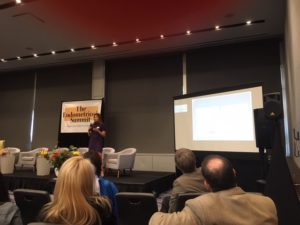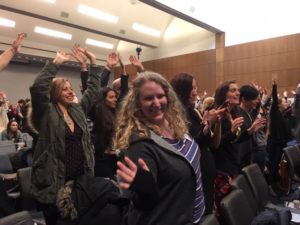

There are no words to describe how incredible The Endometriosis Summit was this past Sunday. “Mind-blowing,” “informative,” and “collaborative” don’t even begin to do it justice. Thanks to the extensive efforts of event co-chairs Dr. Sallie Sarrel, a pelvic floor physical therapist who specializes in endometriosis, and Dr. Andrea Vidali, a specialist in endometriosis excision surgeries and fertility preservation, close to 350 patients and practitioners gathered for this groundbreaking town hall meeting.
The keynote speaker was Heather Guidone, Surgical Program Director of the Center for Endometriosis Care in Atlanta, Georgia. Other speakers included a variety of surgical specialists, physical therapists, and individuals who have endometriosis.
Many important topics were discussed, and I would like to share several of the salient points that emerged from the conversation.
Dr. Iris Orbuch, a minimally invasive surgeon, emphasized the importance of early detection. She described the long, painful medical path endured by most young women with endometriosis. This nightmare of chronic pain coupled with failed medical interventions lasts an average of ten years before a proper diagnosis is made. Symptoms worsen while the endometriosis continues to grow and spread. Therefore, in order to prevent years of needless suffering and to optimize fertility, it is our duty as medical care providers to be familiar with the symptoms of endometriosis and to refer patients to endometriosis specialists immediately.
The mission of early detection is being spearheaded by Shannon Cohn, filmmaker, attorney, and endometriosis activist. Cohn, who was featured in a previous blog entitled “The Most Common Disease You Never Heard Of” (link to blog), has produced Endo What, a documentary about endometriosis. In addition, she educates school nurses about endometriosis in order to help them detect it in their students. They are often the first health care providers with whom symptoms are shared. The more knowledgeable they are about the disease, the more equipped they will be to suspect its presence and refer appropriately.
Dr. Allyson Shrikhande, a pelvic pain physiatrist who performs pelvic floor muscle injections to address overactivity, shared two red-flag signs for endometriosis. Namely, a history of difficulty inserting tampons and difficulty tolerating speculum examinations. She strongly encouraged using these indicators as guides.
Occult inguinal hernias may be a co-morbidity of endometriosis, and they can be a hidden source of pain. Dr. Mark Zoland is a general surgeon who has specialized in treatment of such hernias. He explained that many radiologists are focused solely on herniation of organs, not fatty tissue. However, fatty tissue which has herniated through the abdominal wall can compress nerves and result in pain the same way an organ might. Therefore, he emphasized the importance of having diagnostic studies read by doctors who will be on the lookout for fatty tissue herniation in addition to organ herniation.
Last but certainly not least, we had the privilege of hearing from one of my favorite pelvic floor physical therapists, Dr. Holly Herman. Dr. Herman has been practicing for over thirty-five years, and she is one of the founders and pioneers of pelvic floor physical therapy. On a personal note, she co-taught the first pelvic floor continuing education class that I ever took, and it is in part thanks to her that I fell in love with the specialty. In addition to her many contributions as a pelvic floor specialist, she is also a certified sexuality counselor, and she moderated a panel entitled “Safety, Sexuality, and Gender Inclusivity.” This discussion was eye-opening on many levels. The importance of avoiding binary language and respecting patients’ preferred titles was emphasized. Dr. Herman shared that one of the ways she does so is by asking her patients, “Do you have any sexual concerns or preferences that if I knew about, I could treat you better?” She reported that this open-ended question creates a safe environment for the patient, and that she has found it to be encouraging to individuals who may have had prior negative heteronormative experiences.
I would like to highlight one of the panel members, Cori Smith. Cori is a transgender endometriosis advocate and “Endo brother.” He explained to us that endometriosis is not only a “woman’s problem,” and that people should be aware that there are men who suffer as well. He encouraged the audience to reconsider the typical ways that we quote statistics and discuss the disease. For example, Cori aptly pointed out that the commonly quoted statistic, “On average, it takes over ten years for a woman to be properly diagnosed with endometriosis” could just as easily be stated with the more generic “it takes over ten years for endometriosis to be properly diagnosed.” It only takes a modicum of thought and sensitivity for ALL patients to feel comfortable.
There you have a small sampling of the information shared at the summit. I am so grateful that Mandie and I were able to experience this together and to learn more about this topic. We both look forward to applying what we learned at the summit to our patients and having the opportunity to help those suffering.


